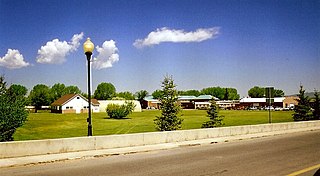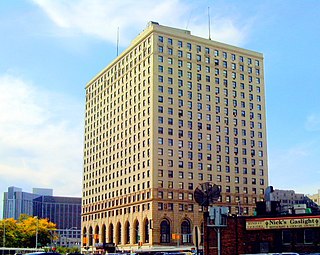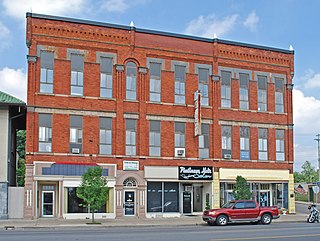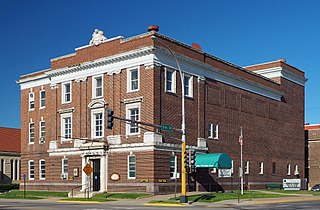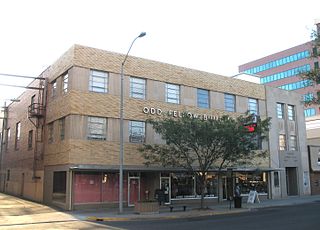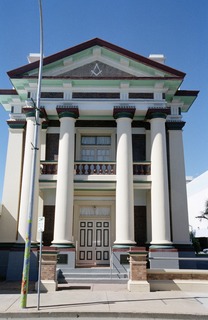Masonic Temple | |
 The front of the building in 2017 | |
| Location | 105 N. Center St., Casper, Wyoming |
|---|---|
| Coordinates | 42°51′1″N106°19′27″W / 42.85028°N 106.32417°W Coordinates: 42°51′1″N106°19′27″W / 42.85028°N 106.32417°W |
| Built | 1914 |
| Architect | Shaffer, Homer F.; Ukensky, Gus A., |
| Architectural style | Late 19th And Early 20th Century American Movements, Early Commercial |
| NRHP reference # | 05000926 [1] |
| Added to NRHP | August 24, 2005 |
The Masonic Temple in downtown Casper, Wyoming is a Masonic hall, built in 1914 during a boom time initiated by the development of the Salt Creek Oil Field. Located on a corner site, the temple remains essentially as it was designed by Casper architect Homer F. Shaffer. [2] The four story light-colored brick building rests on a raised basement and is topped by a crenelated parapet. The original windows have been replaced with vinyl units but retain the one-over-one appearance of the originals. Windows extend over the west and south sides. The north side is blank, while the east side is the building's rear facade and has fire escapes and a few windows. [3]

Casper is a city in and the county seat of Natrona County, Wyoming, United States. Casper is the second largest city in the state, according to the 2010 census, with a population of 55,316. Only Cheyenne, the state capital, is larger. Casper is nicknamed "The Oil City" and has a long history of oil boomtown and cowboy culture, dating back to the development of the nearby Salt Creek Oil Field. In 2010, Casper was named the highest-ranked family-friendly small city in the West, and ranked eighth overall in the nation in Forbes magazine's list of "the best small cities to raise a family".

The Salt Creek Oil Field is located in Natrona County, Wyoming. By 1970, more oil had been produced by this field than any other in the Rocky Mountains region and accounted for 20 percent of the total production in Wyoming.
Contents

The interior is arranged, from the bottom up, as basement, a first floor, containing the ballroom, the second floor containing the lodge and banquet rooms, and a second floor balcony. The basement contains a card room and once had a two-lane bowling alley. A now-unused caretaker's apartment is on this level. A boiler room, dining room and kitchen are also found on this level. A half-story up, the main entrance opens into a vestibule with stairs descending to the basement and ascending to the first floor. A ballroom originally occupied most of the first floor, but was converted to a lodge room in 1964. A small orchestra stage was enclosed. Men's and ladies' lounges or card rooms are also on this level. The second floor contains another lodge room, a banquet hall and a kitchen. The rooms on this level have high ceilings. A balcony overlooks the lodge room. [3]
The estimated cost of the temple was $40,000. It was built by local contractor G.A. Ukensky. The ballroom and banquet hall were rented for public gatherings. By 1924 the lodge membership was 533. Homer Schaffer, the architect, practiced as an architect for only a few years between 1912 and 1915. He later became involved in furniture sales before moving to Cheyenne and becoming a car salesman after 1926. In 1931 he and his family moved to Alamosa, Colorado where he operated an electrical contracting business, designing buildings from time to time. [3]

Cheyenne is the capital and most populous city of the U.S. state of Wyoming and the county seat of Laramie County. It is the principal city of the Cheyenne, Wyoming, Metropolitan Statistical Area which encompasses all of Laramie County. The population was 59,466 at the 2010 census. Cheyenne is the northern terminus of the extensive and fast-growing Front Range Urban Corridor that stretches from Cheyenne to Pueblo, Colorado which has a population of 4,333,742 according to the 2010 United States Census. Cheyenne is situated on Crow Creek and Dry Creek. The Cheyenne, Wyoming Metropolitan Area had a 2010 population of 91,738, making it the 354th-most populous metropolitan area in the United States.

Alamosa is a city under Home Rule Municipality that is the county seat and the most populous municipality of Alamosa County, Colorado, United States. The city population was 8,780 at the 2010 United States Census. The city is the commercial center of the San Luis Valley in south-central Colorado, and is the home of Adams State University.






